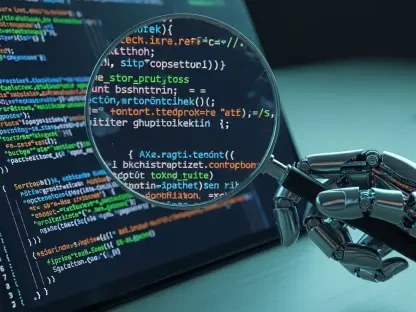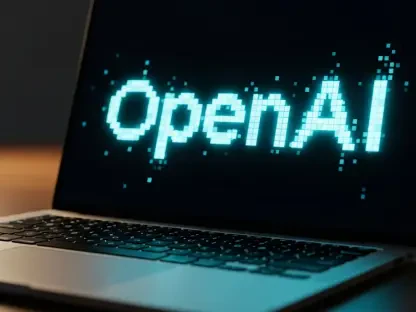Introduction to AI in Software Development
Imagine a world where over half of a developer’s code is written not by human hands, but by intelligent algorithms, reshaping the very fabric of software creation. This is the reality unfolding in the software development industry as AI tools become integral to coding workflows, signifying a transformative shift that streamlines repetitive tasks and accelerates project timelines across diverse teams. The adoption of AI is not merely a trend but a fundamental change in how developers approach problem-solving and innovation. From generating code snippets to debugging complex systems, these tools are redefining efficiency and creativity in the field. Their impact is evident in the way coding practices are evolving to prioritize speed and scalability.
This report draws on data from a comprehensive survey conducted by a leading cloud platform provider between July 10 and July 14 of this year, involving 791 professional developers. The findings illuminate distinct patterns in AI usage, particularly highlighting differences between developers based on their experience levels, setting the stage for a deeper analysis of this technological shift.
AI Adoption Trends by Experience Level
Disparities in AI-Generated Code Usage
A striking revelation from the survey is the significant gap in AI reliance between seasoned and novice developers. Among those with a decade or more of experience, 32% indicated that over half of their deployed code was generated by AI, a stark contrast to just 13% of less experienced developers. This discrepancy underscores a greater willingness among veterans to integrate AI outputs into critical production environments.
Several factors contribute to this divide. Senior developers, with their extensive background, exhibit higher trust in AI tools, viewing them as reliable aids rather than untested novelties. Their confidence allows them to delegate substantial portions of coding tasks to algorithms, a step that junior developers appear more hesitant to take, often due to uncertainty about the technology’s accuracy.
Impact on Efficiency and Productivity
The survey also sheds light on how AI influences work speed, though results are mixed across experience levels. A notable 59% of senior developers reported completing tasks faster with tools like Copilot, Gemini, or Claude, compared to 49% of their junior counterparts. This suggests that AI can indeed enhance productivity, but the extent of its benefits varies.
However, efficiency gains come with caveats. Around 30% of senior developers frequently revise AI-generated code, compared to 17% of juniors, often erasing the time saved by automation. This editing burden highlights a critical trade-off where initial speed is offset by the need for meticulous corrections.
Senior developers seem to navigate these challenges more effectively, likely due to their adeptness at spotting and fixing AI errors. Their deep understanding of coding principles enables quicker validation of outputs, translating into more pronounced speed improvements over time compared to less experienced peers who may struggle with error detection.
Challenges in Leveraging AI Tools
The road to seamless AI integration is fraught with obstacles for developers at all levels. A primary concern is the frequent need for substantial edits to AI-generated code, which can introduce errors or vulnerabilities—sometimes referred to as “vibe coding”—if not carefully managed. Such issues demand a balance between leveraging automation and maintaining rigorous quality checks.
These challenges impact senior developers more acutely due to their higher usage rates. With a larger portion of their work reliant on AI, they face increased exposure to potential flaws, necessitating greater vigilance. Junior developers, while using AI less, may grapple with over-dependence, lacking the seasoned judgment to discern when automated suggestions fall short.
To address these hurdles, a strategic approach is essential. Developers can benefit from combining AI assistance with manual oversight, ensuring that automated outputs are thoroughly vetted. Additionally, fostering a culture of continuous learning about AI capabilities and limitations can empower both groups to use these tools more effectively without compromising code integrity.
Developer Sentiment Toward AI Assistance
Despite the hurdles, the overall perception of AI in coding remains highly favorable. An impressive 80% of surveyed developers expressed that coding has become more enjoyable with AI support, citing the reduction of tedious, repetitive tasks as a key factor. The ability to instantly generate code also adds a layer of satisfaction to the development process.
This positive sentiment transcends experience levels, indicating a broad consensus on AI’s value as a productivity enhancer. Both senior and junior developers appreciate the relief from grunt work, allowing them to focus on more creative and complex aspects of their projects. This shared enthusiasm underscores AI’s transformative potential in the industry.
Experience, however, shapes how this appreciation translates into practice. Senior developers often integrate AI as a trusted partner in their workflow, leveraging it for substantial gains, while juniors may view it as a helpful but secondary resource. This distinction reflects how background influences not just usage but also the depth of reliance on AI tools.
Future Implications of AI in Development
Looking ahead, AI tools are poised to become even more central to software development, with advancements likely to refine their accuracy and functionality. Over the next few years, from this year to 2027, innovations in AI models could further reduce error rates, making them indispensable across all experience levels. Such progress promises to elevate the role of automation in coding.
Beyond technological strides, the industry may see a push toward enhanced developer training focused on AI literacy. Bridging the adoption gap between senior and junior developers will require structured programs that build confidence in using these tools, ensuring that less experienced professionals can harness AI’s full potential without hesitation.
External factors, such as the need for robust security protocols, will also shape AI’s trajectory. As reliance on automated code grows, maintaining critical oversight will be paramount to prevent vulnerabilities. The balance between innovation and caution will define how effectively the development community adapts to an AI-driven future.
Conclusion: Bridging the AI Adoption Gap
Reflecting on the insights gathered, it becomes clear that senior developers have embraced AI with greater intensity, with a significant portion of their code being AI-generated, compared to their junior peers. The survey paints a picture of enhanced productivity tempered by the need for edits, with experience playing a pivotal role in navigating these dynamics.
As a next step, the industry should prioritize tailored training initiatives to empower junior developers, helping them build trust in AI tools through hands-on learning and mentorship from seasoned professionals. Simultaneously, tool developers need to focus on refining AI algorithms to minimize errors, addressing the editing burden that often diminishes efficiency gains.
Looking forward, fostering a collaborative environment where knowledge-sharing bridges experience gaps emerges as a vital strategy. By investing in education and innovation, the software development community can ensure that AI’s benefits are accessible to all, paving the way for a more inclusive and efficient future in coding practices.









